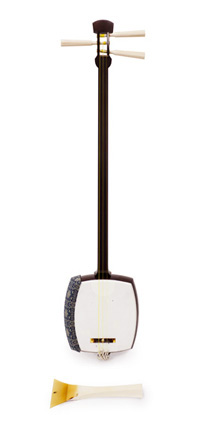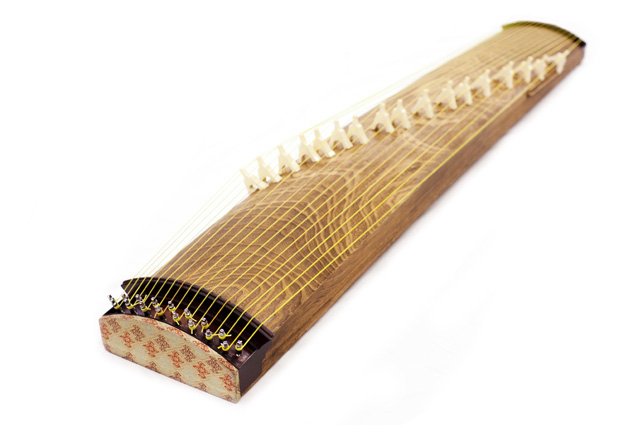![]()
The Origins of the Koto / The Shamisen (Sangen) / The Seventeen-stringed Bass Koto
![]()
The Koto
There are Chinese characters commonly used to represent the koto: 琴 and 箏. In the ancient past, the first character琴and the reading of koto designated all stringed instruments. This first character, however, can also be pronounced kin, and during the Heian period, this reading was commonly used to indicate the seven-stringed Chinese qin, an extremely prestigious instrument associated with mainland literati culture. This instrument differs from the contemporary Japanese koto in that it does not use the movable struts placed under the strings. Instead, the left hand is placed directly on the strings against the body to determine pitch. The Japanese koto is normally distinguished from the kin by the use of the second character箏, and its music is generally referred to as sōkyoku, 箏曲, as 箏 can be pronounced as sō. The second character is not included in the standardised set of Chinese characters studied in Japanese education, and therefor the distinction between the two has become unclear. It is thus very common to see the second character commonly used in a variety of contexts.
The Origins of the Koto
The koto entered Japan from mainland during the Nara period (710-794) as one of the instruments forming gagaku. During Japan’s Middle Ages, a solo repertoire for the koto appeard; however, in the 17th century, Yatsuhashi Kengyō (1614-1685) established the early modern koto practice, which is the origin of contemporary koto. During the early Edo period, the blind musicians that created this new genre began performing the koto with the shamisen, an instrument that had just arrived in Japan. In the Kansai regions, Ikuta Kengyō (1656-1715) established the Ikuta-school tradition, while Yamada Kengyō established the Yamada-school tradition in Edo, present-day Tokyo.
The Instrument and Performance
The koto is a long box-like hollow body of paulownia wood over which thirteen silk or tetoron strings are attached, with a movable strut under each string, which allows for tuning. The performer places the instrument in front and uses the first three fingers of the right hand, all with plectra or picks to produce sound, while the left hand is used to manipulate pitch and produce a variety of effect by pushing or pulling on the string to the left of the strut. The fundamental tuning is hirajōshi in which the root of the early modern scale—D, E flat, G, A, B flat, D—is placed on the fifth string. (The pitches indicated here are not absolute, and any pitch can serve as the fundamental.) The full tuning with D as the fundamental pitch is therefor: D, G, A, B flat, D, E flat, G, A, B flat, D, E flat, G, and A. The resonance of this scale is immediately recognisable as ‘Japanese’!

![]()
The Shamisen (Sangen)
In the many genres of Japanese music, the shamisen is the most commonly used instrument. The shamisen studied by the Ikuta-school musicians is a mid-sized instrument (chūzao) commonly referred to as a sangen.
During the Eiroku era (1558-1570), the progenitor of the Japanese shamisen, the sanshin, arrived in the port city of Sakai from the Ryūkyū Islands. Scholars believe that this instrument underwent modifications, which resulted in today’s shamisen. This new instrument was immediately popular and very quickly developed into a large number of different genres. The shamisen was extremely important in the various theatre forms that appeared during the Edo period, notably bunraku and kabuki, and is unquestionably the representative musical instrument of the early modern era.
The instrument is formed of a body covered on both sides with either dog or cat skin, and the neck passes through the body. Three strings of differing gauges pass over a bridge, and the performer normally performs with a plectrum held in the right hand, while the left hand is used to create pitch and other effects on the fretless neck.
The body can be made from Chinese quince, evergreen oak and other woods, while the neck is commonly made from red sandalwood, rosewood, Chinese quince, and other woods. The skin covering the body can be dog, cat, or synthetic. The strings are usually silk or nylon polymer. The plectrum can be made from a variety of materials including ivory, tortoise shell (the playing edge), and different plastics or acrylics.

![]()
The Seventeen-stringed Bass Koto
In 1921, Miyagi Michio designed the seventeen-stringed bass koto to provide the bass-line in ensemble format derived from Western music. The overall design is the same as the thirteen-stringed koto; however, the width, the length, and the thickness of the body are all accordingly larger, and the strings are also thicker. A commonly used tuning is a diatonic scale from C on the lowest string to E on the highest, but like the standard koto, the strings are tuned by movable bridges and the instrument can be tuned in a variety of ways. While originally designed as an ensemble instrument, the seventeen-stringed bass koto now boasts and extensive solo repertoire. It has often been compared to the Western ‘cello.

![]()
![]()

